
Data as a resource is crucial for Malaysia’s development and growth, former Minister of Communications and Multimedia Gobind Singh Deo has said.
“I’m of the view that data as a resource is essential in realising visions of the smart digital future, consisting of smart cities, and even autonomous cars,” he said at a cybersecurity conference in Singapore recently.
However, data is more often becoming the target of cybercriminals across the region and Malaysia is no exception. “Over half of all reported cyber crimes have data theft as their goal”, he added.
The free and trusted flow of data and information is a “strategic asset” for economies. Gobind further said, “Failing to embed effective security measures will erode trust and thereby undermine the stability of our information society. Our digital economies, and the platforms on which they are built, cannot be more of a source of risk than a source of development.”
Malaysia has seen a series of data breaches across industries in the last two months, which should serve as serious warnings to what’s possible in the future. In October, hackers targeted the country’s oldest university, and defaced its payments website. They went on to leak 24,000 login IDs and passwords online, according to reports.
And the month before that, attackers claimed a TV network as a victim, accessing customers’ IC data - including names, ID numbers, dates of birth, and address. The network, that serves 23 million people and 77% of households in Malaysia, said 0.2% of its customers were affected.
Also in September 2019, a Malaysian airline subsidiary had its passenger data stolen and put up for sale on the dark web. The data was stolen by two former employees of a contractor in India, the company found.
CyberSecurity Malaysia has said that there were 178 data breaches as of September this year, compared to 63 and 19 in 2018 and 2017, respectively. Meanwhile, a survey by insurer Chubb showed that 84 percent of local SMEs were attacked last year.
In response, the government has proposed stricter penalties and stronger data regulations. “We should impose a heavier penalty for data breach offenders, including companies that neglected security aspects when it comes to safeguarding customers’ data,” the CEO of CyberSecurity Malaysia, Datuk Dr Amirudin Abdul Wahab, has said.
Gobind said that the country’s data protection laws need to be updated. “We have laws that have been in place since 2010, and I think we have reached a point where we need to improve on it,'' he said.
While regulations are catching up, hackers are getting more ambitious and resourceful. For instance, the attack on Singapore’s healthcare system last year “was a deliberate, targeted and well-planned cyber attack” and that “it was not the work of casual hackers or criminal gangs”, the CEO of the Singapore’s Cyber Security Agency said.
Gobind also warned that Malaysia is at risk as long as security remains an “afterthought”. He called on businesses to do more to protect customers. “By working together, we ensure that we not only anticipate, but also protect ourselves against cyber threats and cyber attacks”.
TM One, recognising that cybersecurity is most crucial in today’s Hyperconnected Ecosystem, continuously strengthens its security offering for customers. In November 2019, we launched three new products during the Cybersecurity Day which was held at TM One Experience Centre recently.
The three new products are: a Next Generation Firewall, a Managed Security Operations Centre, and Intelligent Threat Defence. These tools will provide comprehensive coverage for the critical industries that we serve every day, while allowing them to focus on their customers.
The Next Generation Firewall is powered by artificial intelligence to continuously analyse weaknesses in networks and applications, detect malwares and botnets, and protect against DDOS attacks, amongst other sophisticated attacks.
It is the world’s first AI-enabled application firewall and powered by Engine Zero and Neural-X. Engine Zero is a AI-enabled gateway anti virus provide both signature and behavior based malware detection. And Neural X, is a AI enabled cloud-based intelligence and analytic platform against unknown cyber threats. Artificial Intelligence (AI) has powered and expands security detection capabilities for TM One’s network, endpoint, and security-as-a-service offerings.
The Managed Security Operations Centre helps centrally manage user access and provides real-time dashboard for vital security insights on network, data and application, incident reports and analysis. Customers have the option to deploy this for on-premise data or to monitor activities in their cloud.
It uses SIEM, an Intelligent tool that predict and alert customer on the attacks by using data collected from customer logs on security devices such Firewall & IPS, Network, Server and End-Point. It also notifies customer when incidents, threats and anomalies occur, to help organization ensure that their network is secure.
TM One’s Intelligent Threat Defence system provides an automated solution to secure the entire network, without having to deploy additional systems. It stops the loss of confidential data and uses machine learning to block data exfiltration attacks.
It is a cybersecurity solution that utilises analytics and machine learning technology. Through real-time streaming analytics of live DNS queries and machine learning to accurately detect presence of data in DNS queries, it detects and automatically blocks attempts to steal intellectual property via DNS without the need for endpoint agents or additional network infrastructure.
“For businesses, where IT network and data are extremely valuable assets, it is crucial for all to take cybersecurity seriously. No organisations, whether they are small or large, are immune from cyberattacks.” Mohd Roslan Mohd Rashidi, Vice President of Sales at TM One, said during the launch. “These new products are evidence of TM One’s continuous readiness and commitment to provide the latest solutions, working together with our partners and cybersecurity experts, to ensure that our customers are able to protect their most critical assets, so that they can conduct their business with peace of mind,” he added.
It can be challenging Working From Home (WFH) while juggling an entire household and keeping productive with work. Here are some tips on making the best of both worlds
Set up a daily schedule for your work and your family members – time for eating, time for Work & Study, time for exercise, time for house chores
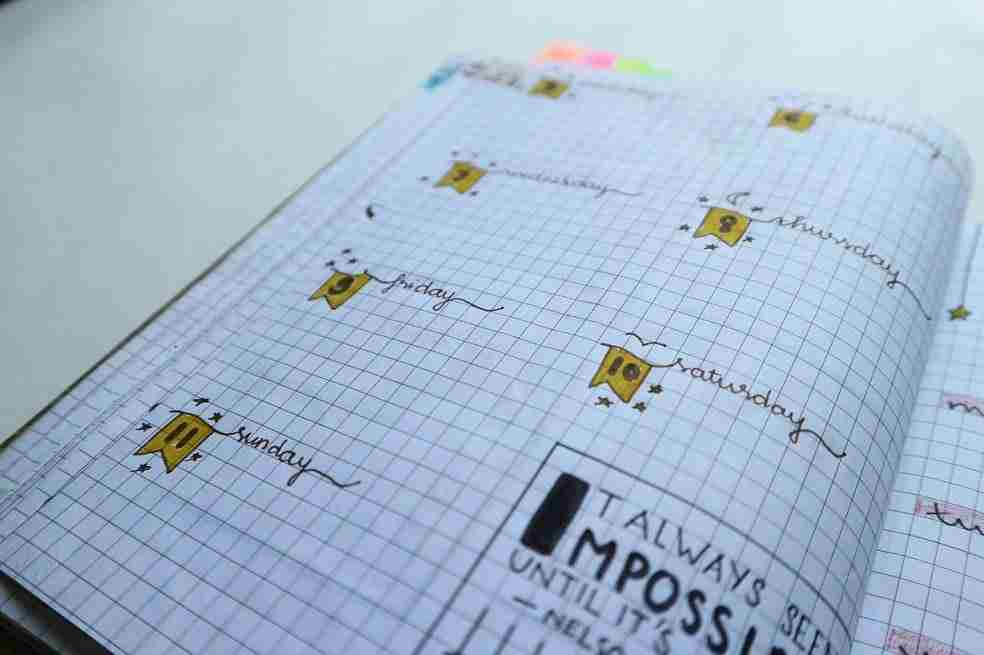
Getting up earlier than the rest of the family gives you the quiet time you need for productivity

Puts you, your mind and those around you in a ‘work’ mode

Use that space only for work stuff
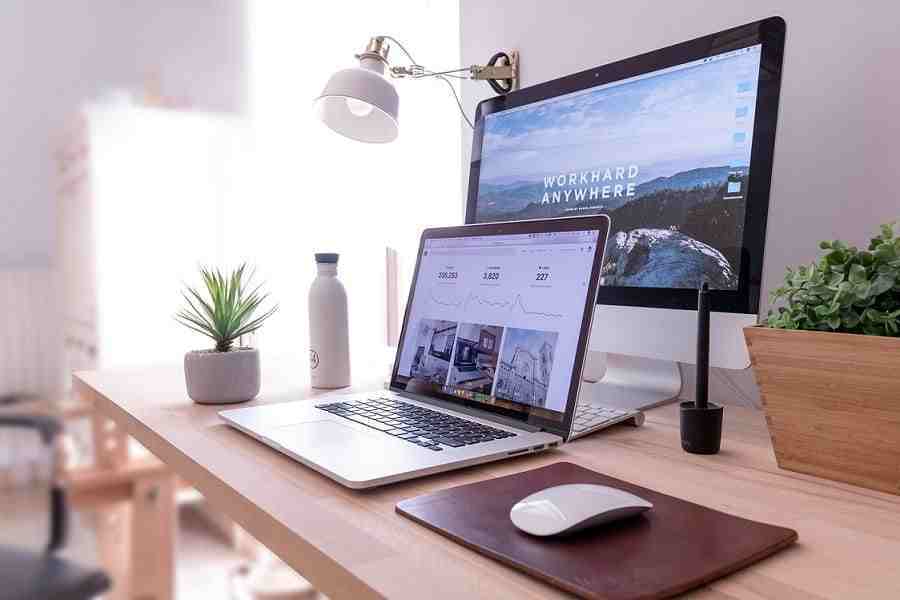
It’s easy to forget task while juggling family and home chores

Go to bed early

1. Use collaboration tools like Google docs, Slack, Trello or Asana – saves time and unnecessary texting and chatter
2. Some popular and user friendly video conference tools that you and your colleagues can use are Skype, WhatsApp and Zoom. These tools can also be used for keeping in touch with extended family members
3. Meal prepared for a few days in advance – double your recipe and freeze for another day
#sTayhoMe #stayconnected #stayinbusiness #stayontopofthings #DigitalMalaysia
Quantum theory states that every particle in the universe is connected with one another, no matter how remote.
This is becoming ever more evident in our world at large, as cities and nations sync up to the internet - with citizens across the global able to connect across distances that were unimaginable a mere generation ago.
This hyperconnectivity is causing a revolution in Malaysia - a big bang as it were - that is bringing cities into the modern age. GovInsider has looked at how three Malaysian organisations are using new tech to make a difference to their citizens.
Just 25km from Kuala Lumpur’s twin towers sits Subang Jaya, the fifth most populous municipality in Malaysia. The local government is using connectivity to tackle three issues.
First, it is addressing traffic congestion. As TPr. Noraini Roslan, President of the Subang Jaya Municipal Council notes: “The more traffic we have on the road, the more fuel we burn, the more unhealthy the city becomes, [and] the worse it is going to be, as far as climate change is concerned,” she said. Subang Jaya must revisit its traffic flow to reduce congestion, and is using IoT to do so.
The second issue is flooding. In Subang Jaya, flash floods occur during heavy rain even when it rains for only a short period of time, say, two hours. With the predictive capabilities of smart technologies, city authorities can monitor weather forecasts and water levels, and help keep flooding at bay.
Third, smart devices can also help monitor the improper disposal of construction debris. Keeping an eye on construction sites and common dumping grounds can weed out illegal dumpers and stop the act before it is even committed, saving the time and resources needed to clean up the areas.
This all depends on reliable connectivity. “Without good connectivity, services cannot be delivered at the time when people need it most,” she said.
We now turn to the northwestern coast of Malaysia, in the bustling town of Penang. The city’s water utility, Perbadanan Bekalan Air Pulau Pinang (PBAPP), is not afraid of exploring new solutions with emerging technologies.
Sustainability has become one of PBAPP’s top concerns. The company has to make its infrastructure more durable and reliable. In tropical Malaysia, where temperatures often go up to 35 degrees Celsius in the afternoon, outdoor equipment has to be designed to withstand the heat. They also have to be waterproof to guard against frequent flash floods.
Smart metering is helpful. This tech has only just started gaining traction in utility boards around the region, but PBAPP made their first attempt at a pilot project 20 years ago. Currently, they are working with TM ONE to use smart metering for their water supply.
PBAPP is looking to replace manual water reading for high rise buildings and gated properties. “This has taken a long time because the experts and the market were not ready,” noted Dato' Ir. Jaseni Maidinsa, CEO of PBAPP. “We intend to adopt appropriate technologies,” he added, of PBAPP’s approach to new technology. PBAPP’s focus on adopting new technology is not without good reason. “We want the whole ecosystem to be ready."
For Sunway group, a Malaysian conglomerate, connectivity will improve its services across its businesses, which cover 12 industries including retail, education, property management and education.
The company is automating services across the group, said Khoo Hsien Li, former Director of Sunway Computers Services. “The end result is that a student can interact with a merchant in the mall, and the mall can cross-sell something to someone visiting the theme park, and so on,” he elaborated. A hyperconnected ecosystem enables an omni-channel engagement, enriching overall customer experience and an improved profitability for businesses.
But the company is not just concerned about making profits. Sunway University is running lessons and courses on sustainability as part of the United Nations Sustainable Development Programme.
“That is only 20,000 students, there are a lot more people outside of the universities,” said Khoo. Connecting Sunway’s businesses can possibly help in pushing forth Sunway Group’s efforts to educate a larger group about sustainability.
In all of these stories, data is crucial. From Sunway University to Subang Jaya, new tech is making a difference. And TM ONE is at the centre of it all.
Many leaders are commenting that they are seeing an upsurge in the use of business tools and services in the last few weeks.
According to American customer service software company Zendesk’s Benchmark Snapshot, of the 23,000 companies that use their services, the three (3) biggest industries that have seen spikes in support requests since late February are restaurants (230%), grocery brands (160%), and remote work and learning (150%).
On-premise networks are often not able to cope with a sudden rise in users accessing company applications, as the quality of network resources comes under severe pressures.
Meanwhile, here at home, there have been a few reports of organisations experiencing big jumps in traffic during the Movement Control Order (MCO) period, putting strain to their network and resources, and necessitating an overnight infrastructure upgrade. TM One as the nation’s digital enabler for enterprises and public sector, have played our part in helping our customers, to weather challenges whenever and wherever required.
COVID-19 – the ultimate disruptor
Research analyst firm IDC last year found that around 80% of Malaysian businesses have yet to be part of the digital transformation journey. Will it be different in the aftermath of COVID-19? As it stands, we are witnessing many businesses disrupted from their status quo and begin to embrace digitalisation – although out of necessity more than discretionary.
Nonetheless, we should be positive about the future of Malaysian economy. History has shown us that in times of crisis, human ingenuity rises up to meet even the toughest challenges. The emergence of a new normal in the way people and businesses work, operate and live today shows that we are able to adapt to the most rapidly changing and disruptive environment.
Of course, the extent to which each entity is able to cope with the disruption and challenges vary. As part of consulting firm PwC’s 2019 Global Crisis Survey, it found that companies are able to not only survive in times of crisis, but also emerge even stronger in the aftermath, as a result of being prepared and having effective stakeholder communications.
It also found that these companies become stronger due to having supported by data-driven decision making. Having a big data initiative in place ensures that businesses can respond effectively and swiftly, based on dynamically evolving set of data.
Analyst firms such as Omdia (formerly Ovum) expects Malaysian businesses will view the COVID-19 pandemic as a catalyst to sharpen their business continuity measures and change the way they do business.
Ideally, enterprises should have a specific pandemic-focused business continuity plan already prepared, says the Omdia report, but – as an alternative – repurposing an existing one that covers “civic emergencies” should suffice.
“The plan should incorporate a tiered response, clearly identifying the actions to be taken at each level and the circumstances that would trigger implementation of the next level,” notes the document.
The Watershed Moment
Remote/home workers will need to connect to their business applications, data, and other services to have any semblance of normal working. Using a Virtual Private Network (VPN) is a common practice, although it exacerbates the issue of internet bandwidth - and often becomes the bottleneck, according to network specialists.
The bottom line is that COVID-19 is a watershed moment. The overnight adoption of working from home is the most dramatic disruption of our times.
A recent survey found that 49 percent of workers have never worked from home. As we move forward in the coming months and years, this new paradigm will become mainstream. All the appropriate technologies, and cloud infrastructure services are already on hand to ensure companies can operate from both home and the office.
In his closing remarks of LEAP Summit last year, Ahmad Taufek Omar, Executive Vice President and Chief Executive Officer of TM One said: “Every disruption pivots on creativity – a new vision, a new insight of how technology can uplift people and their goals onto a more agile, faster path.”
Quite simply, there is a cultural shift underway and one which is expected to last beyond post-COVID-19.
Ahmad Taufek also commented on the cultural changes required for digitalisation during an interview last year, "Culture is a critical factor underlying a successful transformation. Mindsets form just one element within the culture. Today, it is crucial that we ensure people’s mindsets are primed and ready for the digital journey. Companies, whether they are big or small, must be ready to change their mindsets to stay relevant and to adapt to the new order of the economy."
Drivers can waste a lot of time looking for somewhere to park, making it hard to plan their journey and contributing to congestion. At the same time,municipalities can find it hard to collect payments: a parking attendant may have to scan number plates one-by-one to check each vehicle’s payment status. This method consumes a lot of time and manpower. For both drivers and municipalities, the root cause of their parking problems is a lack of real-time data, drivers don’t know where the empty spaces are and the authorities don’t know the payment status of vehicles parked in ticketed bays.
To give drivers and authorities real-time information, mobile operator TM ONE has developed a smart parking solution, which can show drivers where spaces are via a smartphone app and a dashboard accessible through any device connected to the Internet. It also provides parking authorities with a single platform through which they can monitor all the spaces under their purview.
The solution combines cameras and sensors, connectivity, artificial intelligence (AI), data visualisation and analytics on a single platform. The data captured by sensors and cameras are processed by an AI system at the edge of the network, which
then transmits the metadata via TM ONE’s 4G network to the cloud to be analysed and displayed on the smart parking dashboard. As a result, drivers and municipalities can see all the information they need, including real-time availability and payment
status. Drivers can even use the smartphone app to book a vacant parking space before they arrive.
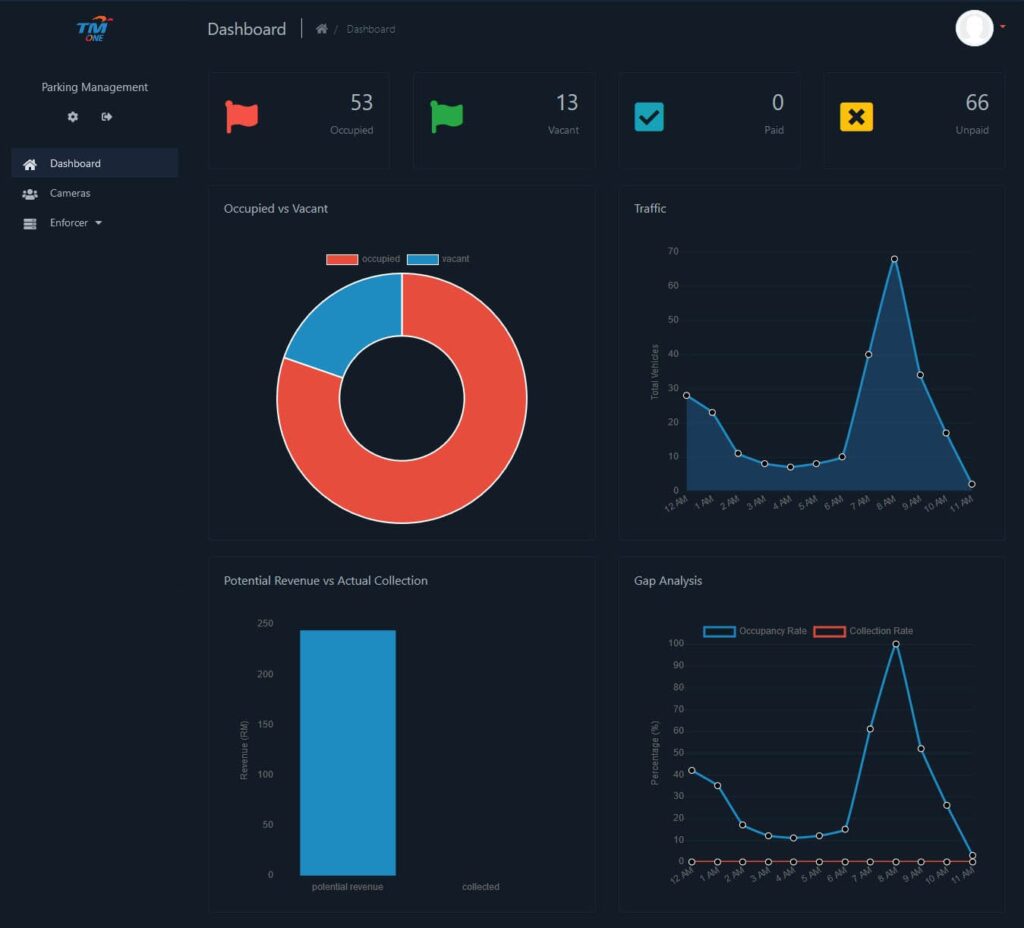
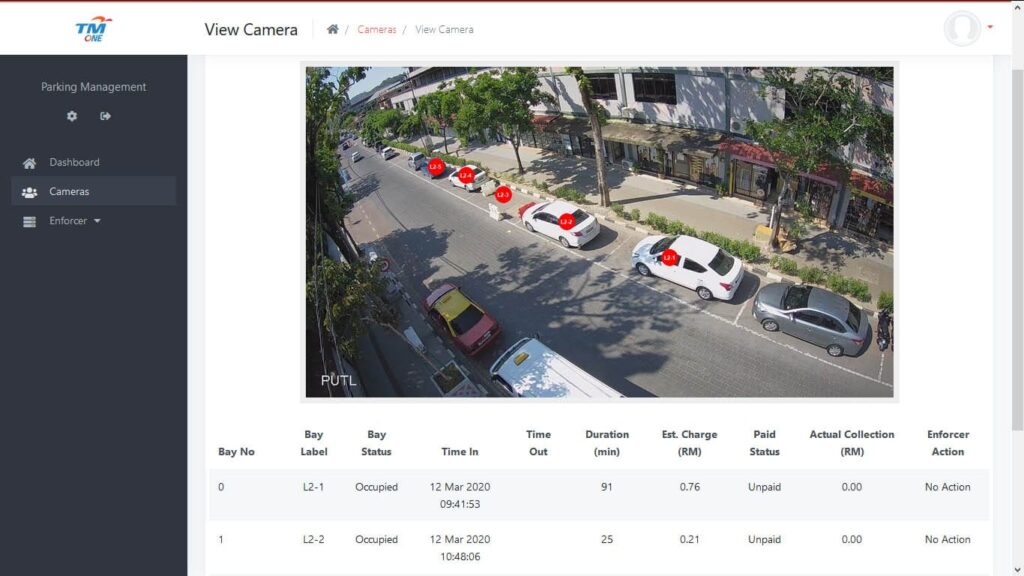
For parking attendants, the solution can pinpoint vehicles with unpaid or expired parking fees, making enforcement fast and accurate. It can also be used to vary prices according to demand. TM ONE says that will translate into higher revenues and lower operation costs for the local councils or parking operators that run the outdoor parking spaces.
TM ONE has deployed its smart parking solution for Majlis Perbandaran Subang Jaya, the local authority that manages the infrastructure and municipal services in Subang Jaya city in Malaysia. The end-to-end service includes the smart parking solution, a mobile app drivers can use to pay for a space, a round-the-clock service helpdesk and a monitoring and management centre.
TM ONE is now enhancing the smart parking solution further. For example, it is integrating parking space availability alerts with a navigation system to guide drivers to the nearest empty parking spot. The operator also plans to provide parking attendants
with a smartphone app and a compound ticket printer, which can be integrated with other parking systems.
As 5G connectivity becomes available in Malaysia, TM ONE has also piloted the solution over 5G in Subang Jaya as part of the field trial organised by the Malaysian Communication and Multimedia Commission (MCMC). The 5G-enabled smart parking supports real-time video streaming from AI-based cameras to enable the detection of irregular behaviour, thereby providing safety and surveillance capabilities.
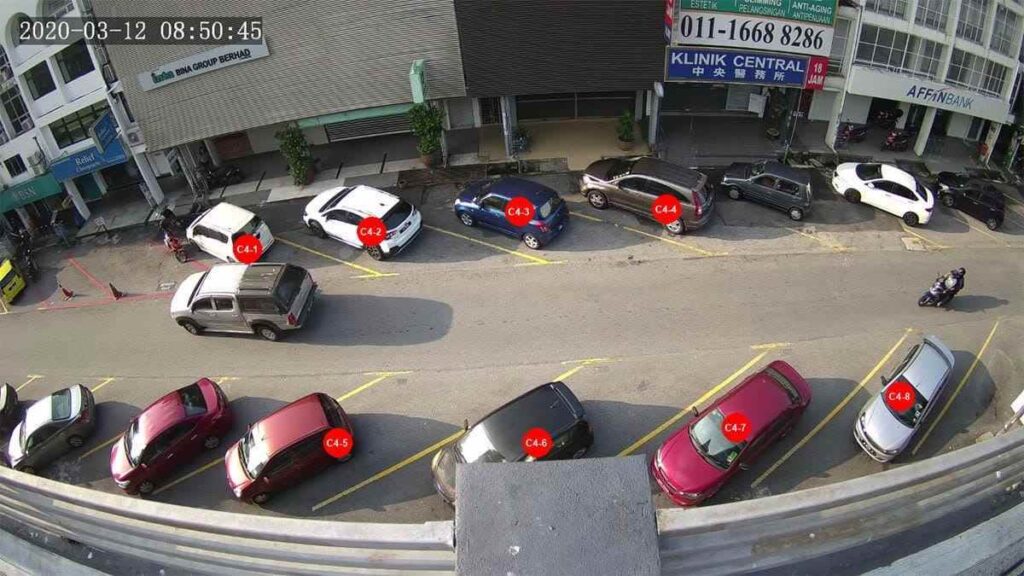
This article was first published on GSMA
Off the northwestern coast of Malaysia lies a cluster of islands renowned for pristine beaches and glistening waters. Langkawi, also known endearingly as the Jewel of Kedah, plans to bring five million tourists onto its shores in 2020.
The island paradise wants to create a safe haven – tourists shouldn’t have to worry about bringing their mirrorless cameras, smartphones and Fitbits along on vacation. “The most important and serious issue that we need to see beforehand is the possibility of crimes. We need to solve this issue first before it happens,” said Azrin Aris, Director of Products & Innovation at TM One, the enterprise and public sector business arm of Telekom Malaysia (TM).
TM One, along with TM’s innovation arm TM Research & Development (TM R&D), has pioneered several 5G-enabled solutions to make Langkawi safer for guests and locals alike. TM is testing these solutions in their 5G Langkawi trials, taking place from December 2019 until first half of 2020. Here is how Langkawi will improve the safety of its public spaces, tourist hotspots and construction sites.
TM R&D has developed smart, AI-powered cameras that can identify the emotions of passers-by. “The camera can detect microexpressions, and it’s in this that we have many different use cases for security,” said Dr. Sharlene Thiagarajah, CEO of TM R&D in a media showcase in January.
The cameras can help to identify terrorists before they act, for instance. “If there’s somebody who has a very determined angry look on their face, it would probably suggest that they want to do something bad,” she said. TM R&D built the microexpression recognition algorithm in-house, so they were able to tailor it for Asian features, shared Dr Sharlene.
Thanks to the larger volume of data 5G networks can support, these cameras can record high-definition footage in real time – an important feature for identifying potential suspects. “You can zoom in and still have good clarity for facial recognition,” explained Azrin. The higher number of connections 5G can support in an area also means that more cameras can be installed, so authorities can cover more ground.
TM One’s ‘panic’ buttons, mounted on lamp posts in crowded tourist hotspots, will make contacting authorities during emergencies much easier.
Once activated, these buttons send alerts and live footage of the area to authorities in the central 5G command centre. People can also communicate directly with the authorities through the cameras next to the buttons.
The command centre is conveniently located right in the heart of Langkawi’s Municipal Council office. This means that when somebody makes a distress call, authorities can immediately dispatch the relevant services, such as the ambulance or fire brigade, to help.
To complement this, TM R&D has built a geolocation app so users can identify where traveling family members are. The app alerts users whenever a ‘panic’ button is activated, and updates users of safe zones within Langkawi. “We wanted a tool for families to be able to register their loved ones and then identify safe zones so people know their family is in a safe area,” said Dr Sharlene.
Safety isn’t just for tourists; just as important are the workers building the islands’ infrastructure. For the construction industry, TM R&D has developed a smart safety helmet that can make worksites safer. Its most salient feature is that it allows live communication between workers and supervisors. “There are a lot of cases of handphones dropping and crashing while people are calling to report incidents or ant nests at the site,” shared Dr Sharlene.
High-definition cameras on the helmet will allow supervisors to conduct live, wireless monitoring of on-site happenings. This comes in handy during staff training. Supervisors can provide detailed guidance while remaining in the operation centre, where they can have a better vantage point.
The smart helmet is also particularly useful in emergencies. Besides providing live footage of accidents, the helmet can inform supervisors of the exact location of a worker trapped under rubble, or of the severity of a fall. If it’s a high-impact fall, supervisors will know to send the worker to a hospital to check for a concussion.
As Langkawi prepares to usher in more visitors this year, safety has become a prime concern. With TM’s 5G networks and the array of smart solutions they have enabled in Langkawi, holidayers can be assured that help will always be just a button away; citizens can keep updated on their traveling family members’ safety; and the construction industry can better protect its workers.